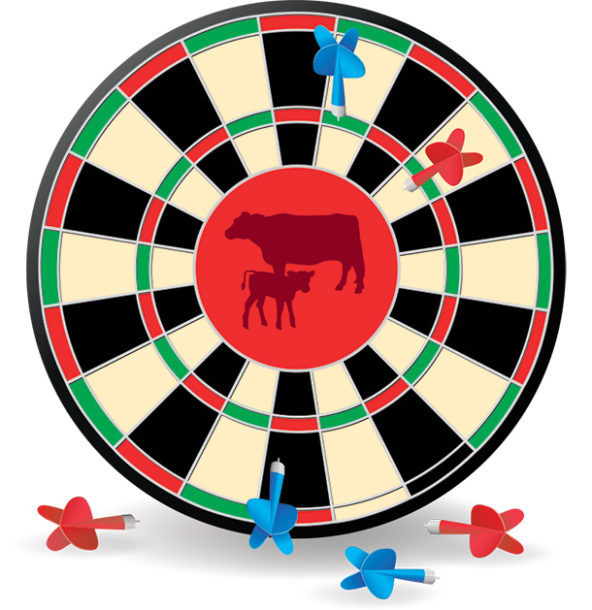Do you read reproductive or animal health questions posted on some Facebook pages? Someone is disappointed in calf health or herd reproduction and asks something along the lines of “Why did our cows not breed back very well this year?”
The ensuing responses run the gamut, including vaccine and even antibiotic recommendations. Occasionally, someone might ask about body condition, bull fertility or nutrition, but many of the responses are like shutting your eyes and throwing a dart in the direction of a dartboard. While reproductive efficiency or failure can be complicated (many moving parts), the parts can be effectively managed. And while nature might throw a wrench in our herd breeding plans, we can achieve acceptable results most years by managing each part of the reproductive system and understanding how one practice has a ripple effect on future results.
Understanding reproductive efficiency as a system is crucial for cow-calf herd success. Pregnancy has significantly greater economic impact than any other production trait, and reproductive efficiency is more important than growth or carcass traits for the cow-calf producer. While fertility is the most significant factor for cow herd success, infertility costs producers more than scours, calf respiratory disease or any other non-fatal disease. Infertility can be defined as a cow failing to breed, breeding but not delivering a live calf or breeding late. The fact is: If the calf isn’t born alive and healthy and weaned, we don’t have anything to sell.
It is natural to think about fertility the day we turn bulls out. For the cow, though, fertility is a lifelong issue beginning even before birth. Studies out of Nebraska show that heifers born from cows supplemented during pregnancy reached puberty early in life, were cycling when bulls were introduced, bred early their first year and subsequently calved early. Heifers that calve early their first year have a longer, more productive life than those that breed and calve later in the season. Their male herdmates born to supplemented cows also had higher weaning weights and rates and outperformed their non-supplemented counterparts, so supplementing pregnant cows pays dividends.
Viewing the whole system
Managing events is worthwhile, for sure. There have been many articles about how to intervene during calving to improve calving success and make sure calves get colostrum, which is essential for calf health. Timely intervention also benefits future cow fertility as well. Very soon, there will be articles about estrous synchronization and artificial insemination (A.I.), which has been shown to have production and genetic benefits for our herds. As well, other articles will explain the value of breeding soundness exams and bull fertility, and others how to assess cow herd body condition to improve fertility. And more might explain the pros and cons of herd vaccination programs.
All these elements of the system are important. At some point, we need to step back or even take a drone-level look at the whole system or cycle and see how all these events are related and impact subsequent events either positively or negatively.
Fetal programming
Cow fertility begins before birth. This is referred to as fetal programming. Cow nutrition and environment during pregnancy impacts future herd fertility. Once heifers are born, then how we raise them (or how their mom raises them) matters. Heifers born late in the calving system or born to heifers or cows with poor body condition often wean lighter and don’t reach puberty soon enough to breed early as replacements. In fact, any cow or heifer that calves late in the calving season or in poor body condition is at risk of breeding late again or not breeding at all. It takes 90 days or more for heifers or cows that calve in poor body condition to start cycling again after calving. This doesn’t give them much time to get bred before the bulls are removed.
Heifer selection
Selecting heifers for fertility and longevity is essential for lifetime productivity. Developing heifers to reach puberty so they breed early their first year is crucial. Traditional methods of heifer selection rely on physical traits such as weight, age and pregnancy status to determine who to keep. Genomic tools show potential to identify the more productive heifers earlier than traditional, phenotypic selection tools. However, selecting heifers by physical traits and overall phenotype is still a valuable tool to build a fertile cow herd. Proper management, use of proven heifer selection tools and use of estrous synchronization and A.I. to breed heifers early are effective tools to produce productive heifers that have longevity.
Body condition
Managing cow herd body condition score (BCS) is vital, and preg check time is a great time to assess and manage body condition. Collecting cow information such as pregnancy status, BCS and condition of teeth are all essential information for managing cow herds. Thin cows can be fed or turned onto better pasture to gain condition before calving. Managing body condition during the dry period between weaning and calving is the most efficient time to do so. This improves calf health and cow fertility. Cows with short or missing teeth can be fed differently or just culled if feed inventory is marginal.
Bull fertility
Don’t underestimate the impact of bull fertility. Using fertile bulls will get more cows bred earlier than subfertile bulls. Bulls that pass a pre-season breeding soundness examination produce more calves and heavier calves than bulls that don’t pass or bulls that haven’t been examined. Fertile bulls get more cows bred in the first service. Subfertile bulls can take two or more services to get cows bred. Every cycle a cow goes open is 40 to 50 pounds of calf lost at weaning, so testing bulls and only using fertile bulls helps keep more cows bred and bred early.
We can do everything to effectively manage our cow fertility, but a subfertile bull can wreck the system. Bulls need to maintain good body condition and be in good condition for the breeding season – BCS 5-6 is optimal. Off-season management and a complete nutrition plan for the bull pen, including adequate vitamins and minerals, and performing a thorough BSE 45 days prior to breeding season are essential.
Vaccination programs
Cow herd vaccination programs can be confusing. There a lot of cattle vaccines out there. Not only is there a variety of vaccine options; then you have to decide who needs to be vaccinated, when they need it and with what. Some vaccines stimulate immunity to viruses. Some viral vaccines contain killed viruses, and some contain a modified live version, and some contain both killed and modified live viruses. It is best to work through this with your veterinarian and design a program specific to your operation’s needs. Vaccination programs have three main goals: increase immune resistance against common diseases in livestock, protect the fertility of the cow herd and provide protection for calves marketed off the ranch.
Herd reproduction is more than just getting cows pregnant. It is also about getting live, healthy calves and helping them grow to their genetic potential, getting cows to rebreed after calving and for cows to produce enough milk for their calves to grow and flourish. Herd reproduction is a system with many parts that need to work together to achieve success. A few simple steps and a strategy to manage our herd’s fertility will make for some good, healthy, productive cows and a lot of personal pleasure of raising good cattle.
Check out our Progressive Cattle podcast featuring Lee Jones discussing year-round reproduction issues with the editorial team (Managing year round reproduction with veterinarian Lee Jones).








